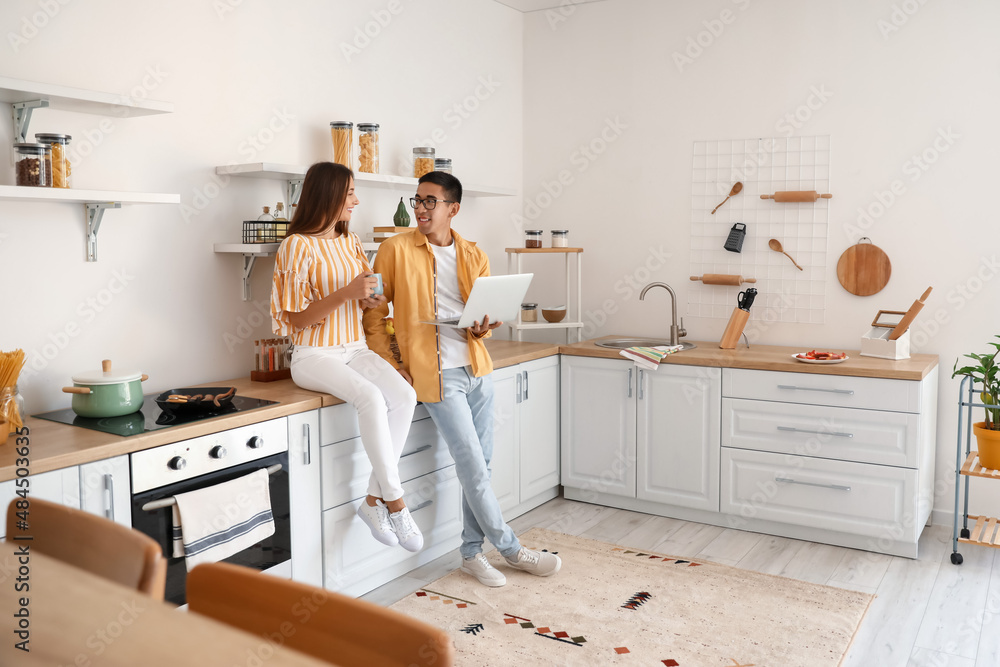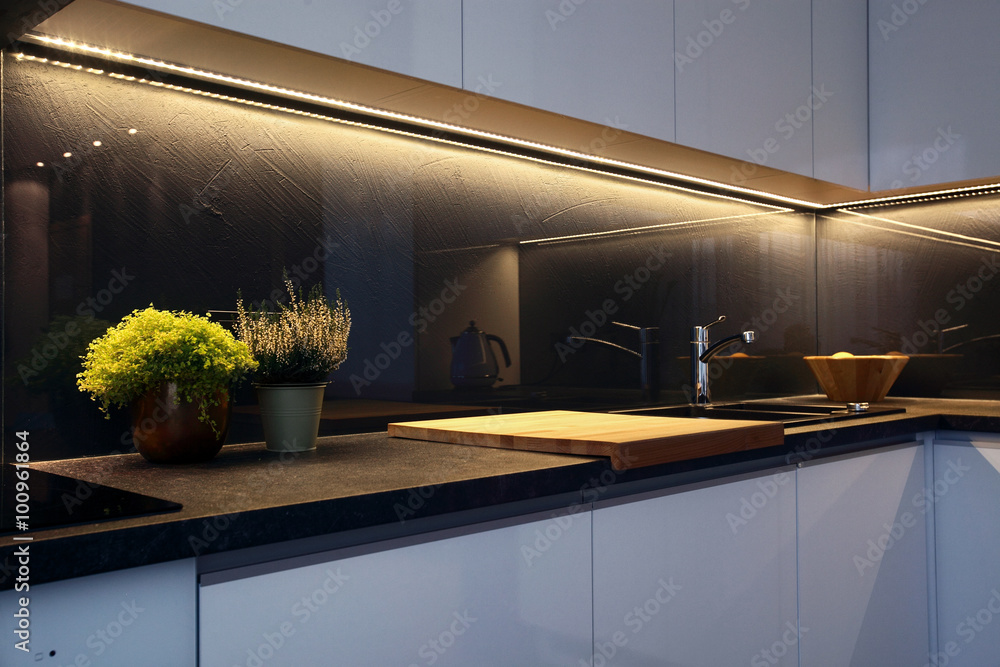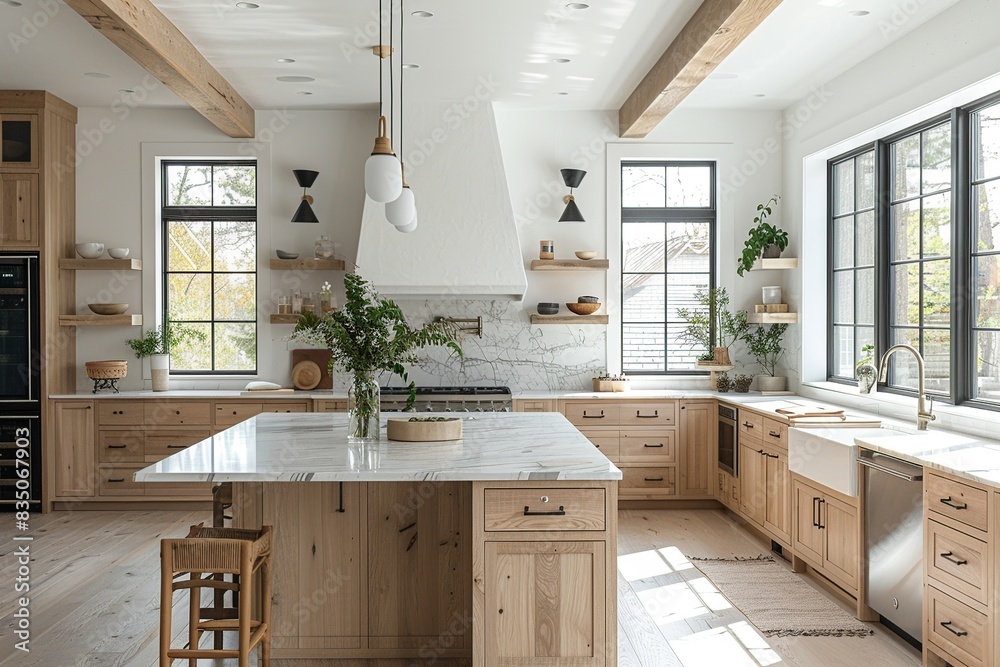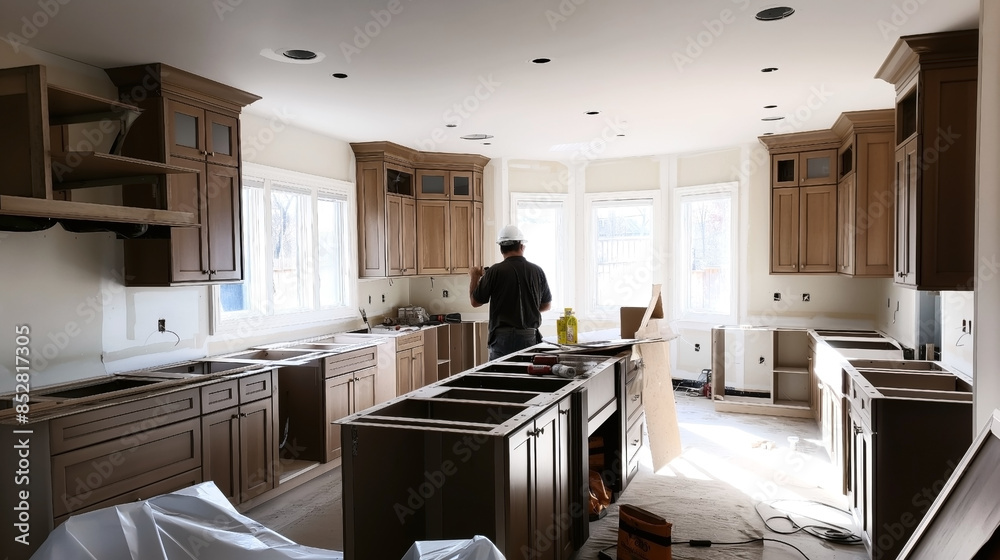1. Plan Your Layout Carefully
Overview: The layout of your kitchen is crucial for optimizing functionality. In a small kitchen, every inch of space must be used wisely to ensure efficient workflow and ease of use.
Key Layouts:
- Galley Kitchen: This layout features two parallel walls with a narrow walkway in between. It’s ideal for small spaces as it maximizes storage and counter space.
- L-Shaped Kitchen: An L-shaped layout uses two adjacent walls, creating an open area that can serve as a dining space or additional storage.
- U-Shaped Kitchen: A U-shaped kitchen surrounds the cook with workspace on three sides, offering plenty of counter space and storage.
Tips:
- Work Triangle: Ensure the work triangle (sink, stove, and refrigerator) is efficient and unobstructed to facilitate easy movement.
- Compact Appliances: Choose smaller appliances that fit the scale of your kitchen but still meet your needs.
2. Maximize Storage Solutions
Overview: Storage is often a significant challenge in small kitchens. Effective storage solutions can help you keep your kitchen organized and clutter-free.
Key Strategies:
- Vertical Storage: Utilize vertical space by installing cabinets that reach the ceiling. Use the upper shelves for items you use less frequently.
- Open Shelving: Open shelves can make a small kitchen feel more spacious and are perfect for storing everyday items.
- Pull-Out Drawers: Replace lower cabinets with pull-out drawers for easy access to pots, pans, and other kitchen essentials.
Tips:
- Hooks and Racks: Install hooks and racks on walls or the inside of cabinet doors to store utensils, pots, and pans.
- Under-Cabinet Storage: Use the space under cabinets for items like cutting boards, small appliances, and dish racks.
3. Choose the Right Appliances
Overview: In a small kitchen, the choice of appliances can significantly impact both functionality and aesthetics. Opt for compact and multifunctional appliances to save space.
Key Appliances:
- Compact Refrigerators: Choose a smaller refrigerator that fits your space without compromising on storage capacity.
- Slimline Dishwashers: A slimline dishwasher can save valuable cabinet space while still providing the convenience of automatic dishwashing.
- Combination Appliances: Look for appliances that serve multiple purposes, such as a microwave with convection oven capabilities.
Tips:
- Built-In Appliances: Integrate appliances into your cabinetry to create a seamless and tidy look.
- Drawer Appliances: Consider drawer-style appliances, like microwave drawers and dishwasher drawers, for space efficiency.
Join HICP Homeowner’s Alliance
Connect with experts, get special discounts and enjoy member benefits
4. Optimize Counter Space
Overview: Counter space is a precious commodity in a small kitchen. By optimizing your counters, you can create a more functional cooking area.
Key Strategies:
- Multi-Purpose Surfaces: Use surfaces that can serve multiple functions, such as a cutting board that fits over the sink.
- Minimalism: Keep counters clear of clutter by storing small appliances and utensils in cabinets or on shelves.
- Folding Surfaces: Install folding or pull-out countertops that can be extended when needed and tucked away when not in use.
Tips:
- Portable Islands: A portable kitchen island can provide additional prep space and storage without permanently occupying floor space.
- Counter Extensions: Consider counter extensions or overhangs that provide extra workspace without needing additional floor space.
5. Incorporate Smart Lighting
Overview: Good lighting is essential in a small kitchen. Proper lighting can make the space feel larger and more inviting, as well as improve functionality.
Key Lighting Types:
- Ambient Lighting: Provides overall illumination for the kitchen. Recessed lighting or a central ceiling fixture can serve this purpose.
- Task Lighting: Focuses on specific work areas like countertops, the stove, and the sink. Under-cabinet lighting is ideal for task lighting.
- Accent Lighting: Adds visual interest and highlights design elements. Consider pendant lights or LED strips for accent lighting.
Tips:
- Layered Lighting: Use a combination of ambient, task, and accent lighting to create a well-lit and versatile space.
- Natural Light: Maximize natural light by using light-colored window treatments and keeping windows unobstructed.
6. Select Appropriate Colors and Finishes
Overview: Color and finish choices can significantly influence the perception of space in a small kitchen. Lighter colors and reflective surfaces can make the space feel larger and more open.
Key Strategies:
- Light Colors: Use light colors for walls, cabinets, and countertops to create a bright and airy feel.
- Glossy Finishes: Glossy or reflective finishes on cabinets and backsplashes can enhance light and make the kitchen appear larger.
- Monochromatic Palette: A monochromatic color scheme can create a cohesive look and reduce visual clutter.
Tips:
- Accent Colors: Introduce accent colors through accessories, backsplashes, or small appliances to add interest without overwhelming the space.
- Consistency: Maintain consistency in colors and finishes to create a harmonious and uncluttered appearance.
7. Integrate Functional and Stylish Design Elements
Overview: Functionality and style can coexist in a small kitchen. By incorporating practical yet stylish design elements, you can create a kitchen that is both beautiful and efficient.
Key Elements:
- Backsplash: A stylish backsplash can serve as a focal point while protecting walls from spills and splashes. Consider materials like subway tiles, glass, or stainless steel.
- Hardware: Choose sleek and modern hardware for cabinets and drawers to add a touch of elegance.
- Flooring: Durable and easy-to-clean flooring materials like tile, vinyl, or laminate are ideal for small kitchens. Patterned tiles can add visual interest.
Tips:
- Decorative Storage: Use decorative containers, jars, and baskets to store items on open shelves or countertops.
- Greenery: Incorporate plants or herbs to add a touch of nature and freshness to your kitchen.
8. Personalize Your Space
Overview: Personal touches can make a small kitchen feel more inviting and uniquely yours. Consider adding elements that reflect your personality and lifestyle.
Key Personalizations:
- Artwork: Hang artwork or prints that you love on the walls.
- Textiles: Use colorful or patterned dish towels, rugs, and window treatments to add warmth and personality.
- Cookware Display: If you have beautiful or unique cookware, consider displaying it on open shelves or hanging racks.
Tips:
- Seasonal Decor: Change up small decorative items seasonally to keep your kitchen feeling fresh and updated.
- Sentimental Items: Incorporate sentimental or meaningful items, such as family heirlooms or handmade crafts, to personalize the space.
Conclusion
Creating a functional and stylish small kitchen requires thoughtful planning and design. By carefully considering your layout, maximizing storage, choosing the right appliances, optimizing counter space, incorporating smart lighting, selecting appropriate colors and finishes, integrating functional and stylish design elements, and personalizing your space, you can transform your small kitchen into a beautiful and efficient culinary haven.
Remember, the key to a successful small kitchen design is to make the most of the space you have while maintaining a balance between functionality and aesthetics. With these tips and strategies, you can create a kitchen that not only meets your practical needs but also reflects your personal style and enhances your overall living experience.








